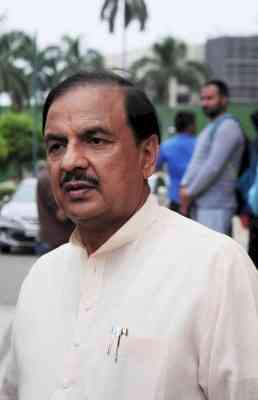OPINION: Good money that has gone down the drain
Author(s): Joginder SinghThe Author. Thousands of crores of rupees have been spent to revive the dying Yamuna. Yet, in most parts of Delhi, the ancient river continues to dry and get dirtier by the day. Some Government schemes are like...


The Author.
Thousands of crores of rupees have been spent to revive the dying Yamuna. Yet, in most parts of Delhi, the ancient river continues to dry and get dirtier by the day.
Some Government schemes are like bottomless pits — no matter how much money you invest in them, there is nothing to show for in the form of significant results. In October, the Supreme Court of India posed a question regarding the cleaning of the Yamuna and other rivers. It asked what had been achieved after putting in so much money towards conserving that river. “Where has all this money gone? We don’t see any improvement in the water of the river”, the apex court observed, and rightly so. After all, a combined sum of nearly Rs12,000 crore has been spent by the Union Government and the State Governments of Delhi, Haryana and Uttar Pradesh, on cleansing the Yamuna. However, most of the money seems to have gone down the drain.
Affidavits filed by the Governments of Delhi and Uttar Pradesh reveal that they have spent Rs4,124 crore to make the Yamuna waters potable. Also, the New Delhi Municipal Council and the Municipal Corporation of Delhi have spent an additional Rs315 crore on cleaning the Yamuna. The Delhi Jal Board has said that it has spent approximately Rs2,072 crore on similar efforts to revive that river. Even the Delhi Development Authority has put in around Rs30 crore to develop land along the river.
In fact, between the two States and their civic bodies, a whopping Rs4,439 crore has been spent on the Yamuna in the past 18 years. And that is not all. The Union Government has recently disclosed that by June of this year, it had spent more than Rs1,540 crore on different phases of the Yamuna Action Plan and the Jawaharlal Nehru National Urban Renewal Mission.
Unfortunately, almost the entirety of this amount supposedly spent on the Yamuna has quite literally gone down the drain. This is because as many as 18 Delhi drains discharge their untreated or semi-treated waste and other effluent into the Yamuna. On its part, the Government has sought to wash its hands of the matter by pointing to the many unauthorised and irregular colonies in the national capital. According to the authorities, these colonies indiscriminately dump their waste into the Yamuna and, therefore, it is they who must be held responsible. However, the Government forgets that handling illegal colonies is part of its own job.
Rampant corruption across the country only makes the matter worse. Furthermore, the fact that there are no means to measure either the effectiveness or even the quality of the work done means that whole idea of cleaning the river has remained a distant dream. Also, since the work is done by a Government agency, where responsibility is diffused and accountability is almost non-existent, nothing more than wastage of money is to be expected.
The first step towards getting anything done is to figure out how to measure the effectiveness of the work that is do be done. Quantifying and measuring the work done leads to better monitoring, more control and overall improvement. After all, if you cannot measure the amount of work which is being done, you cannot really understand the project. And if you cannot understand it, then you cannot control it. And, if you cannot control it, you cannot effectively implement it.
Unfortunately, rivers in this country are choked with rubbish, refuse and weeds. The Government has been more than liberal with funds for river cleaning projects, especially for the Ganga and the Yamuna rivers. But, there is no single monitoring authority to ensure that the several agencies involved in different projects do not work at cross purposes and waste money. A multiplicity of agencies, doing their bit of work, without coordinating with others, is a waste of resources. It leads to work being done neither here nor there. The Government should immediate consider the establishment of one main agency that will be accountable and responsible for completing the work according to a pre-determined time-schedule. This, of course, should not be seen as an excuse to bring back the notorious Inspector Raj of earlier years.
Other steps that the Government must take to protect not just the Yamuna but also other rivers in the country include, for example, making available septic tanks so that water can be treated before it moves into discharging pipes. This should be made compulsory in for all cities and towns located on river banks. Also, overall hygiene levels need to be improved. But for this, better infrastructure — in the form of clean public toilets, for instance — is necessary. As of now, it is impossible to find even dustbins on the streets and in public spaces in general. Consequently, people just litter the street or throw rubbish into open drains, which then either get clogged or carry the waste into the nearest river.
The problem is that the Government chews more than it can digest. It has a finger in every pie. The result is that nothing gets done, either to the satisfaction of the people or the courts or even the Government.
Little wonder then that, even as far back as 1983, Biological Oxygen Demand in milligram/litre stood at 117 tonnes per day for the Yamuna while the national standard is three milligrams per litre (higher the BOD, worse the quality of water). Now, take into consideration the fact that the length of the Yamuna in Delhi is 48 km and 22 drains empty waste into the river at the Wazirabad barrage in Delhi.
In other words, the river is almost dead in Wazirabad. While presenting a report to a bench of the Supreme Court, the Central Pollution Control Board said on November 10 that, “Yamuna is a drain. Fresh water does not flow in the river. Almost 37 per cent of the sewage flowing through Delhi’s drains enters the Yamuna untreated, posing serious concerns to the river’s health”.
After assessing the sewage treatment capacity of Delhi, the CPCB found that at optimum utilisation level 17 sewage treatment plants are capable of treating 2,460 million litres per day. But the city generates sewage at an average of about 3,800 MLD. To make matters worse, even the optimum capacity of 2,460 MLD is not being treated. Sewage Treatment Plants are able to treat only 1,558 MLD sewage (63 per cent of installed capacity), allowing the untreated effluent to directly flow into theYamuna. It is shameful that the Government is not able to provide clean drinking water even to citizens residing in the national capital.
The Rs12,000 crore spent on the Yamuna has not just gone down the drain but also into the pockets of those who were responsible for the project. Anyway, there is no fear of the law of the land. Some of our politicians, in collaboration with obliging bureaucrats, have wreaked havoc with the schemes otherwise meant for development and poverty alleviation. Perhaps, it is time to turn the laws the other way — maybe an accused should be presumed guilty until proven innocent. Let the onus lie on the accused to prove that assets acquired by him are not the spoils of the projects with which he or she has been associated.

 cityairnews
cityairnews 














